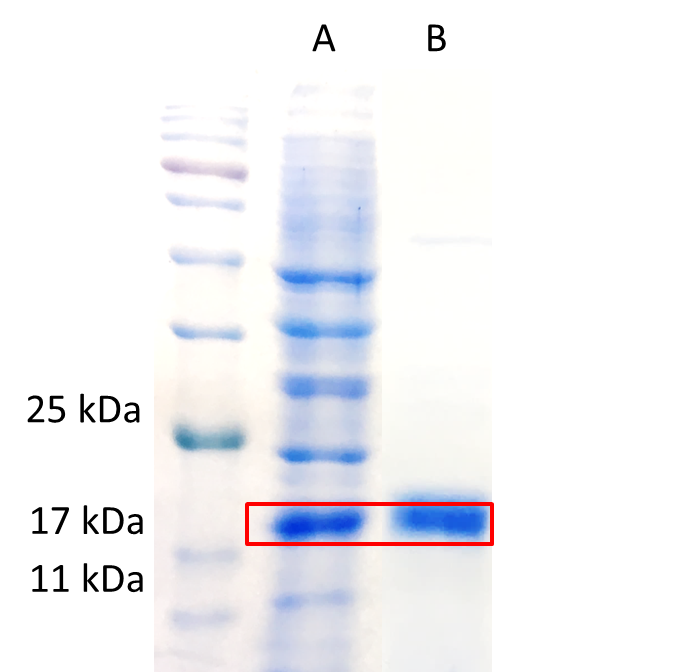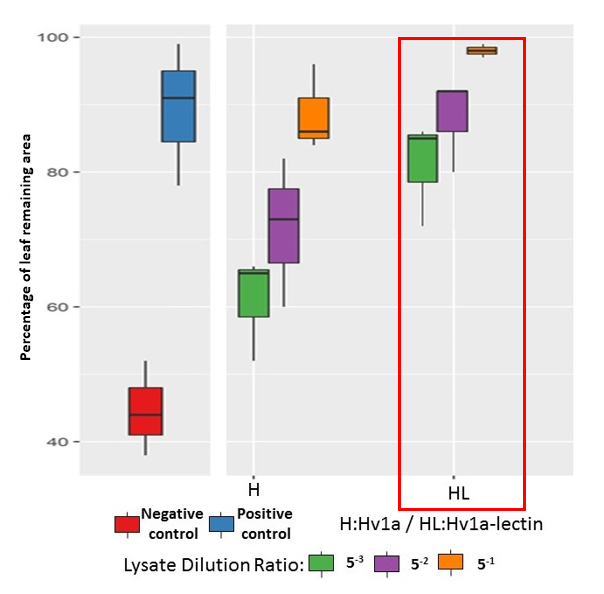Part:BBa_K1974021
T7Promoter+RBS+Hv1a+linker+snowdrop-lectin+linker+6X His-Tag
Introduction:
By ligating the IPTG induced PT7 (BBa_ I712074), strong ribosome binding site (BBa_B0034), Hv1a, linker, snowdrop lectin (BBa_K1974020.
), and the 6X His-Tag (BBa_ K1223006), we can express Hv1a, the toxin by IPTG induction
This year we create a revolutionary system that integrates biological pesticides, automatic detector, sprinkler, and IoT. We made a database that contains most of the spider toxins and selected the target toxins by programming. Omega-hexatoxin-Hv1a is coded for the venom of a spider, Hadronyche versuta.
It is under the control of the strong PT7. Snowdrop-lectin acts as a carrier that could transport the toxin to insect’s nervous system, hemolymph and can improve the oral activity. A 6X His-Tag is added for further protein purification.
According to reference, snowdrop-lectin is resistant to high temperature and would not be degraded by digestive juice. The species-specificity is based on the toxin, and the snowdrop lectin is the role of the carrier.[1][2]
Mechanism of Hv1a
According to reference, Omega-hexatoxin-Hv1a has a structure called ICK (inhibitor cysteine knot). This kind of structure contains three disulfide bonds and beta-sheet. With this structure, Hv1a can resist the high temperature, acid-base solution and the digest juice of insect gut. Hv1a can bind on insect voltage-gated Calcium channels (CaV1) in the central nervous system, making it paralyze and die eventually.[3][4]
Features of Hv1a
1. Non-toxic
Omega-hexatoxin-Hv1a is non-toxic to mammals and Hymenoptera (bees). Since the structure of the target ion channel is different, omega-hexatoxin-Hv1a does not harm mammals and bees. So it is safe to use it as a biological pesticide.[5][6]
2. Biodegradable
Omega-hexatoxin-Hv1a is a polypeptide so it must degrade over time. After degradation, the toxin will become nutrition in the soil.
3. Species-specific
According to reference, Omega-hexatoxin-Hv1a has specificity to Lepidopteran (moths), Dipteran (flies) and Orthopteran (grasshoppers).
4. Eco-friendly
Compare with chemical pesticides, Omega-hexatoxin-Hv1a will not remain in soil and water so that it will not pollute the environment and won’t harm the ecosystem.
Together, using Hv1a is totally an environmentally friendly way for solving harmful insect problems by using this ion channel inhibitor as a biological pesticide.
Target insect:
Experiment
1. Cloning
After assembling the DNA sequences from the basic parts, we recombined each PT7+B0034+Hv1a+linker+snowdrop-lectin +linker+6X His-Tag gene to pSB1C3 backbones and conducted a PCR experiment to check the size of each part. The DNA sequence length of these parts is around 500~600 b.p. In this PCR experiment, the toxin product's size should be near at 750-900 b.p.Proved that we successfully ligated the toxin sequence onto an ideal backbone.
2. Expressing
E.coli(DE3) expressed the protein and form the disulfide in the cytoplasm. We sonicated the bacteria and purify the protein by 6X His-Tag behind the toxin using Nickel resin column.
3. Purification
We sonicated the bacteria and purified the protein by 6X His-Tag behind the peptide using Nickel resin column. Then we ran the SDS-PAGE to verify the purification and analyze the concentration of PT7 + RBS + Hv1a+linker+Lectin+linker+6X His-Tag.
4.Modeling
According to reference, the energy of Ultraviolet will break the disulfide bonds and the toxicity is also decreased. To take the parameter into consideration for our automatic system, we modeled the degradation rate of the protein and modified the program in our device.Therefore PANTIDE was be test under the Ultraviolet and model the degradation rate. the Protein Electrophoresis was showed below.
5. Device
We designed a device that contains detector, sprinkler, and integrated hardware with users by APP through IoT talk. We use infrared detector to detect the number of the pest and predict what time to spray the farmland. Furthermore, other detectors like temperature, humidity, lamination, pressure of carbon dioxide and on also install in our device. At the same time, the APP would contact the users that all the information about the farmland and spray biological pesticides automatically. This device can make farmers control the farmland remotely.
Results
Pantide-expressed E. coli Rosetta gami strain and diluted it with the three concentration.We applied the sample onto the leaf disks and put five cutworms into the separate cabinets for feeding assays. The positive control in the experiment was to apply Bacillus thuringiensis, which is the most widely-used bioinsecticide. We preserved all the result of the remained leaves sealing with the glass paper and calculated the ratio of the remained area on the leaves. The collected data were analyzed by t – test. Here are the feeding assay results.
Safety
We also confirm the safety of applying Pantide. We sonicated the E. coliwhich expressed Hv1a-lectin and treat it in boiling water about 4 hours and collect the product of interval for 0.5 hour. Then we cultured the products after boiling for about a week and found that there's no bacteria growing in the LB plate. Through this experiment, we could make sure that the product is proved to be safe. Here we see the result.
Reference:
1. Elaine Fitches, Martin G. Edwards, Christopher Mee, Eugene Grishin, Angharad M. R. Gatehouse, John P. Edwards, John A. Gatehouse “Fusion proteins containing insect-specific toxins as pest control agents: snowdrop lectin delivers fused insecticidal spider venom toxin to insect haemolymph following oral ingestion,” Journal of Insect Physiology, 2004, 50, pp.61-71
2. Elaine C. Fitches, Prashant Pyati, Glenn F. King, John A. Gatehouse, “ Fusion to Snowdrop Lectin Magnifies the Oral Activity of Insecticidal Omega-Hexatoxin-Hv1a Peptide by Enabling Its Delivery to the Central Nervous System,”
3. Monique J. Windley, Volker Herzig, Slawomir A. Dziemborowicz, Margaret C. Hardy, Glenn F. King and Graham M. Nicholson, “Spider-Venom Peptide as Bioinsecticide,” Toxins Review, 2012, 4, pp. 191-227.
4. Wang, X.H.; Connor, M.; Wilson, D.C.; Wilson, H.I.; Nicholson, G.M.; Smith, R.; Shaw, D.; Mackay, J.P.; Alewood, P.F.; Christie, M.J.; King, G.F. “Discovery and structure of a potent and highly specific blocker of insect calcium channels,” J. Biol. Chem. 2001, 276, 40306–40312
5. Erich Yukio, Tempel Nakasu (2014, July). Effects of ω-ACTX-Hv1a/GNA, a novel protein biopesticide targeting voltage-gated calcium ion channels, on target and non-target arthropod species. Retrieved from http://hdl.handle.net/10443/2643.
6. Erich Yukio, Tempel Nakasu (2014, July). Effects of ω-ACTX-Hv1a/GNA, a novel protein biopesticide targeting voltage-gated calcium ion channels, on target and non-target arthropod species. Retrieved from http://hdl.handle.net/10443/2643.
Sequence and Features
- 10COMPATIBLE WITH RFC[10]
- 12COMPATIBLE WITH RFC[12]
- 21COMPATIBLE WITH RFC[21]
- 23COMPATIBLE WITH RFC[23]
- 25COMPATIBLE WITH RFC[25]
- 1000COMPATIBLE WITH RFC[1000]
| None |









